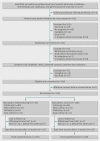Effectiveness of telemonitoring integrated into existing clinical services on hospital admission for exacerbation of chronic obstructive pulmonary disease: researcher blind, multicentre, randomised controlled trial
- PMID: 24136634
- PMCID: PMC3805483
- DOI: 10.1136/bmj.f6070
Effectiveness of telemonitoring integrated into existing clinical services on hospital admission for exacerbation of chronic obstructive pulmonary disease: researcher blind, multicentre, randomised controlled trial
Abstract
Objective: To test the effectiveness of telemonitoring integrated into existing clinical services such that intervention and control groups have access to the same clinical care.
Design: Researcher blind, multicentre, randomised controlled trial.
Setting: UK primary care (Lothian, Scotland).
Participants: Adults with at least one admission for chronic obstructive pulmonary disease (COPD) in the year before randomisation. We excluded people who had other significant lung disease, who were unable to provide informed consent or complete the study, or who had other significant social or clinical problems.
Interventions: Participants were recruited between 21 May 2009 and 28 March 2011, and centrally randomised to receive telemonitoring or conventional self monitoring. Using a touch screen, telemonitoring participants recorded a daily questionnaire about symptoms and treatment use, and monitored oxygen saturation using linked instruments. Algorithms, based on the symptom score, generated alerts if readings were omitted or breached thresholds. Both groups received similar care from existing clinical services.
Main outcome measures: The primary outcome was time to hospital admission due to COPD exacerbation up to one year after randomisation. Other outcomes included number and duration of admissions, and validated questionnaire assessments of health related quality of life (using St George's respiratory questionnaire (SGRQ)), anxiety or depression (or both), self efficacy, knowledge, and adherence to treatment. Analysis was intention to treat.
Results: Of 256 patients completing the study, 128 patients were randomised to telemonitoring and 128 to usual care; baseline characteristics of each group were similar. The number of days to admission did not differ significantly between groups (adjusted hazard ratio 0.98, 95% confidence interval 0.66 to 1.44). Over one year, the mean number of COPD admissions was similar in both groups (telemonitoring 1.2 admissions per person (standard deviation 1.9) v control 1.1 (1.6); P=0.59). Mean duration of COPD admissions over one year was also similar between groups (9.5 days per person (standard deviation 19.1) v 8.8 days (15.9); P=0.88). The intervention had no significant effect on SGRQ scores between groups (68.2 (standard deviation 16.3) v 67.3 (17.3); adjusted mean difference 1.39 (95% confidence interval -1.57 to 4.35)), or on other questionnaire outcomes. Conclusions In participants with a history of admission for exacerbations of COPD, telemonitoring was not effective in postponing admissions and did not improve quality of life. The positive effect of telemonitoring seen in previous trials could be due to enhancement of the underpinning clinical service rather than the telemonitoring communication.
Trial registration: ISRCTN96634935.
Funding: The trial was funded by an NHS applied research programme grant from the Chief Scientist Office of the Scottish government (ARPG/07/03). The funder had no role in study design and the collection, analysis, and interpretation of data and the writing of the article and the decision to submit it for publication. NHS Lothian supported the telemonitoring service and the clinical services.
Conflict of interest statement
Competing interests: All authors have completed the ICMJE uniform disclosure form at
Figures




Comment in
-
Telemonitoring for patients with COPD.BMJ. 2013 Oct 17;347:f5932. doi: 10.1136/bmj.f5932. BMJ. 2013. PMID: 24136632 No abstract available.
References
-
- Gershon AS, Warner L, Cascagnette P, Victor JC, To T. Lifetime risk of developing chronic obstructive pulmonary disease: a longitudinal population study. Lancet 2011;378:991-6. - PubMed
-
- World Health Organization. 2008-2013 action plan for the global strategy for the prevention and control of noncommunicable diseases. WHO, 2008.
-
- Stroetmann K, Kubitschke L, Robinson S, Stroetmann V, Cullen K, McDaid D. EU policy brief 13. How can telehealth help in the provision of integrated care? World Health Organization, 2010.
Publication types
MeSH terms
Associated data
Grants and funding
LinkOut - more resources
Full Text Sources
Other Literature Sources
Medical
